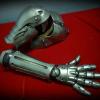Regarding navitoclax toxicity to Sertoli cells and possible solutions:
We know that navitoclax works by inhibiting BCL-2, BCL-XL and BCL-W. These three proteins in turn are responsible for blocking the pro-apoptotic mitochondrial pore-forming proteins BAX and BAK. The balance between these pro- and anti-apoptotic proteins is the deciding factor of whether or not a senescent cell lives or dies.
Sadly, testicular Sertoli cells also exist in a state where this balance is critical to survival and also express some of these pro-apoptotic proteins. Are Sertoli cells senescent? No, but they do bear some of the markers of senescence. For example, see the paper below, where it is found that Sertoli cells are found to express p16Ink4a, a marker of senescence:
Nielsen, G. P., A. O. Stemmer-Rachamimov, J. Shaw, J. E. Roy, J. Koh, and D. N. Louis. “Immunohistochemical Survey of p16INK4A Expression in Normal Human Adult and Infant Tissues.” Laboratory Investigation; a Journal of Technical Methods and Pathology 79, no. 9 (September 1999): 1137–43.
It got me to thinking: Is there a way to selectively down-regulate these pro-apoptotic proteins just in Sertoli cells?
The answer appears to be yes.
Direct modulation of BAX levels in sertoli cells by horomones:
Le Goff, Dominique, Céline Viville, and Serge Carreau. “Apoptotic Effects of 25-Hydroxycholesterol in Immature Rat Sertoli Cells: Prevention by 17beta-Estradiol.” Reproductive Toxicology (Elmsford, N.Y.) 21, no. 3 (April 2006): 329–34. doi:10.1016/j.reprotox.2005.09.003.
I this paper, treatment of SCs with 25-hydroxycholesterol was found to boost levels of BAX mRNA. However, they also found that treatment with physiological concentrations of 17beta-estradiol (estrogen) prevented the apoptosis!
Lucas, Thaís F. G., Carine Royer, Erica R. Siu, Maria Fatima M. Lazari, and Catarina S. Porto. “Expression and Signaling of G Protein-Coupled Estrogen Receptor 1 (GPER) in Rat Sertoli Cells.” Biology of Reproduction 83, no. 2 (August 1, 2010): 307–17. doi:10.1095/biolreprod.110.084160.
In this one, the authors found that 17beta-estradiol treatment of SCs decreased BAX and increased BCL2 expression.
Lucas, Thaís Fg, Maristela T. Pimenta, Raisa Pisolato, Maria Fatima M. Lazari, and Catarina S. Porto. “17β-Estradiol Signaling and Regulation of Sertoli Cell Function.” Spermatogenesis 1, no. 4 (October 2011): 318–24. doi:10.4161/spmg.1.4.18903.
There are three estrogen receptors: ESR1 and ESR2 which are nuclear receptors and GPER which is a G-protein-coupled receptor found in the plasma membrane. In the above paper, the find that activation of the GPER "increases expression of the anti-apoptotic protein BCL2 and decreases the expression of pro-apoptotic protein BAX". So, only one of the three subtypes of estrogen receptor are important for regulating apoptosis in Sertoli cells.
Royer, Carine, Thaís F. G. Lucas, Maria F. M. Lazari, and Catarina S. Porto. “17Beta-Estradiol Signaling and Regulation of Proliferation and Apoptosis of Rat Sertoli Cells.” Biology of Reproduction 86, no. 4 (April 2012): 108. doi:10.1095/biolreprod.111.096891.
In this one, the authors use a GPER specific estrogen agonist to study the anti-apoptotic effects of estrogen.
Simões, V. L., M. G. Alves, A. D. Martins, T. R. Dias, L. Rato, S. Socorro, and P. F. Oliveira. “Regulation of Apoptotic Signaling Pathways by 5α-Dihydrotestosterone and 17β-Estradiol in Immature Rat Sertoli Cells.” The Journal of Steroid Biochemistry and Molecular Biology 135 (May 2013): 15–23. doi:10.1016/j.jsbmb.2012.11.019.
In this paper, the authors study not only estrogen but also DHT and find that they both have anti-apoptotic effects.
So there you go, a Sertoli cell specific way to down regulate BAX and possibly avoid the negative effects of navitoclax on the testes. It helps a lot that 17-beta estridiol (estrogen) is so easy to get (birth control). Now, as a man, I would normally think that estrogen is the last thing that I want in my body. However, if we were to combine estradiol with navitoclax for just a day or two every once in a while, I'm sure the estrogen effects would be negligable or even more likely, zero. Remember that some level of estrogen is healthy in males and that when men want to grow breasts that they also need to take something that inhibits testosterone as well.
My next question would be, would we need to take 17-beta-estridiol or would it be better to take something that was specific for the GPER receptor. From Tocris, here are the options:
Tocris:
17-β-Estradiol (good)
G-1 (very specific but maybe hard to get)
ICI 182,780 (also hard to get)
Quercetin (No thank you: shitty bioavailabilty, plus not specific)
Tamoxifen citrate (Possibly better?)
Tamoxifen and 17-β-Estradiol certainly look the most interesting and both are trivial to obtain. I need to do more reading on Tamoxifen. Tocris lists it as an "Estrogen receptor antagonist/partial agonist... Also high affinity agonist at the membrane estrogen receptor GPER." So maybe β-Estradiol might be better or maybe not.
TL;DR:
Take Estradiol or possibly other estrogen GPCR agonists to selectively down-regulate pro-apoptotic proteins in sertoli cells may be a way of avoiding sertoli cell apoptosis while taking drugs like navitoclax known to kill sertoli cells by that pathway.




















































